The global combination kinase inhibitor market is projected to grow from USD 400.5 million in 2025 to approximately USD 570.4 million by 2035, recording an absolute increase of USD 169.9 million over the forecast period. This translates into a total growth of 42.4%, with the market forecast to expand at a compound annual growth rate (CAGR) of 3.6% between 2025 and 2035. The overall market size is expected to grow by nearly 1.4X during the same period, supported by increasing prevalence of oncological disorders, rising demand for combination therapies, and growing focus on personalized cancer treatment approaches.
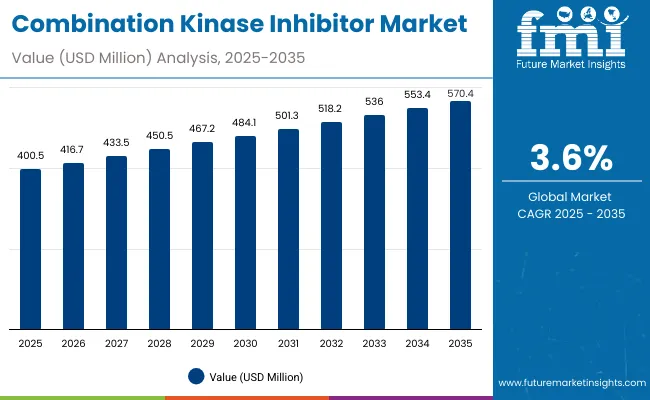
Combination Kinase Inhibitor Market Key Takeaways
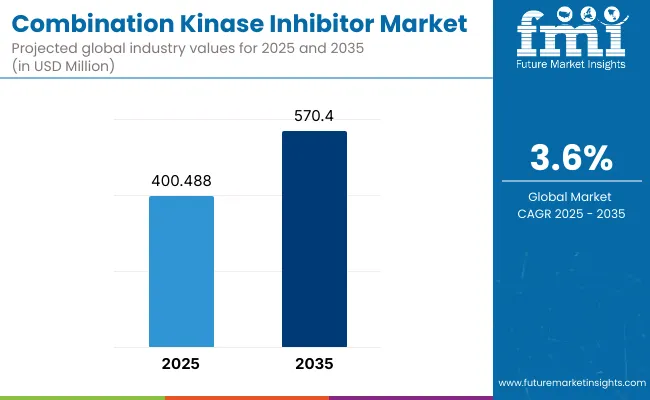
| Metric | Value |
|---|---|
| Estimated Value in (2025E) | USD 400.5 million |
| Forecast Value in (2035F) | USD 570.4 million |
| Forecast CAGR (2025 to 2035) | 3.6% |
Between 2025 and 2030, the combination kinase inhibitor market is projected to expand from USD 400.5 million to USD 478.0 million, resulting in a value increase of USD 77.5 million, which represents 45.6% of the total forecast growth for the decade. This phase of growth will be shaped by rising awareness about targeted cancer therapy options, increasing demand for personalized therapeutic approaches, and growing penetration of combination therapies in emerging markets. Pharmaceutical companies are expanding their combination kinase inhibitor portfolios to address the growing demand for effective treatment solutions for complex oncological conditions.
From 2030 to 2035, the market is forecast to grow from USD 478.0 million to USD 570.4 million, adding another USD 92.4 million, which constitutes 54.4% of the overall ten-year expansion. This period is expected to be characterized by expansion of specialized pharmacy channels, integration of digital health platforms with combination therapy management, and development of personalized treatment protocols. The growing adoption of evidence-based medicine and healthcare provider recommendations will drive demand for clinically proven combination kinase inhibitors with enhanced efficacy and safety profiles.
Between 2020 and 2025, the combination kinase inhibitor market experienced steady expansion, driven by increasing recognition of treatment-resistant oncological conditions and growing acceptance of combination therapy approaches. The market developed as healthcare providers recognized the need for comprehensive treatment solutions to address complex cancer disorders. Clinical research and regulatory approvals began emphasizing the importance of combination therapies in achieving better patient outcomes for challenging oncological conditions.
Market expansion is being supported by the increasing prevalence of treatment-resistant oncological disorders and the corresponding demand for more effective therapeutic approaches. Modern healthcare providers are increasingly focused on combination therapies that can address multiple pathways simultaneously, improve treatment adherence, and reduce the burden of polypharmacy. The proven efficacy of specific drug combinations in treating complex conditions like various cancers, autoimmune disorders, and rare diseases makes them essential components of comprehensive treatment plans.
The growing emphasis on personalized medicine and precision oncology is driving demand for tailored combination therapies that address individual patient needs and genetic profiles. Healthcare provider preference for simplified medication regimens that combine multiple active ingredients in single formulations is creating opportunities for innovative drug development. The rising influence of clinical guidelines and evidence-based treatment protocols is also contributing to increased adoption of proven combination kinase inhibitors across different patient populations and therapeutic areas.
The market is segmented by drug type, indication, sales channel, and region. By drug type, the market is divided into dual-/multi-kinase inhibitors, fixed-dose combinations, and free combinations. Based on indication, the market is categorized into oncology, autoimmune & inflammatory disorders, and rare/orphan indications. In terms of sales channel, the market is segmented into hospital pharmacies, specialty pharmacies, retail pharmacies, and online pharmacies. Regionally, the market is divided into North America, Europe, East Asia, South Asia & Pacific, Latin America, and Middle East & Africa.
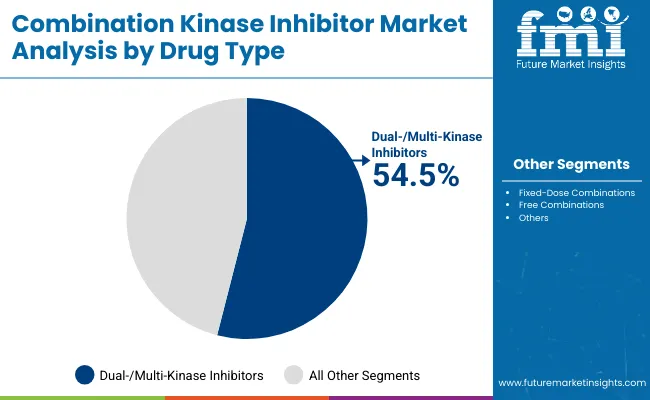
The dual-/multi-kinase inhibitors combination is projected to account for 54.5% of the combination kinase inhibitor market in 2025, reaffirming its position as the category's dominant drug type. Healthcare providers increasingly recognize the synergistic benefits of combining multiple kinase inhibitory mechanisms for treating complex oncological conditions, particularly treatment-resistant cancers and certain autoimmune disorders. This combination addresses multiple pathways simultaneously, providing comprehensive therapeutic coverage.
This drug type forms the foundation of most treatment protocols for severe oncological conditions, as it represents the most clinically validated and widely accepted combination approach in targeted therapy. Regulatory approvals and extensive clinical research continue to strengthen confidence in these formulations. With increasing recognition of the complexity of cancers requiring multi-targeted approaches, dual-/multi-kinase inhibitors align with both acute treatment and long-term management goals. Their broad therapeutic utility across multiple indications ensures sustained market dominance, making them the central growth driver of combination kinase inhibitor demand.
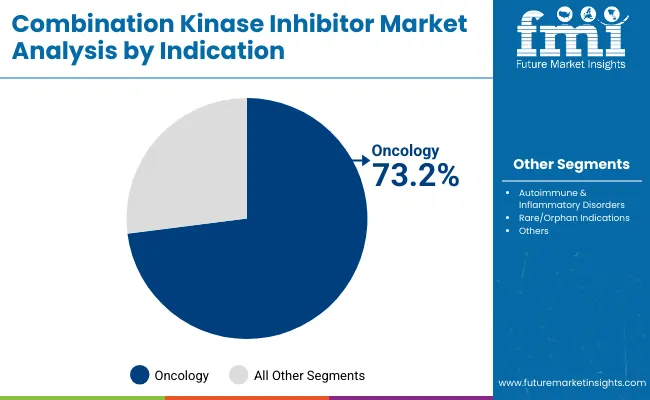
Oncology is projected to represent 73.2% of combination kinase inhibitor demand in 2025, underscoring its role as the primary indication driving combination therapy adoption. Healthcare providers recognize that cancer's complex pathophysiology, including multiple signaling pathways, genetic mutations, and treatment resistance mechanisms, often requires multi-modal treatment approaches that single-agent therapies cannot adequately address. Combination therapies offer enhanced efficacy in managing treatment-resistant cases and reducing relapse rates.
The segment is supported by the chronic nature of cancer requiring long-term therapeutic management and the growing recognition that combination approaches can improve patient compliance and quality of life. Additionally, healthcare systems are increasingly adopting evidence-based treatment guidelines that recommend specific combinations for optimal outcomes. As clinical understanding of cancer's molecular complexity advances, combination therapies will continue to play a crucial role in comprehensive treatment strategies, reinforcing their essential position within the kinase inhibitor market.
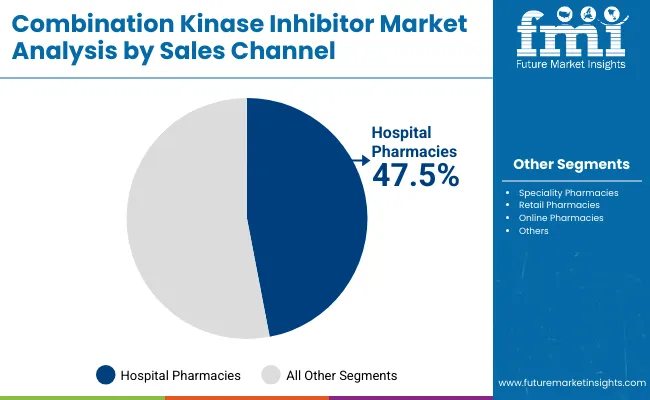
The hospital pharmacies channel is forecasted to contribute 47.5% of the combination kinase inhibitor market in 2025, reflecting the primary role of hospital-based pharmacy services in specialized medication dispensing and patient care. Patients with complex oncological conditions rely on hospital pharmacy services for ongoing medication management, making hospital pharmacies the cornerstone of combination kinase inhibitor distribution. This channel provides essential services including medication counseling, adherence monitoring, and coordination with healthcare providers.
The segment benefits from established relationships between patients and hospital pharmacists, who provide continuity of care and medication management support. Hospital pharmacies also offer advantages in terms of specialized handling requirements, complex preparation protocols, and patient safety monitoring through comprehensive clinical oversight. With growing emphasis on hospital-based cancer care and specialized pharmacy services, hospital pharmacies serve as critical access points for combination kinase inhibitors, making them fundamental drivers of market accessibility and growth.
The combination kinase inhibitor market is advancing steadily due to increasing recognition of treatment-resistant oncological conditions and growing demand for comprehensive therapeutic approaches. However, the market faces challenges including complex regulatory pathways, potential for increased side effects, and concerns about drug interactions. Innovation in combination formulations and personalized treatment protocols continue to influence product development and market expansion patterns.
Expansion of Specialty Pharmacies and Oncology Care Channels
The growing adoption of specialized oncology care facilities is enabling more sophisticated combination therapy management and monitoring. Specialty pharmacies offer comprehensive medication management services, including therapeutic drug monitoring and adverse event management, that are particularly important for complex combination regimens. Specialty care channels provide access to oncology specialists who can optimize combination therapy selection and dosing.
Integration of Digital Health Platforms and Medication Management Systems
Modern pharmaceutical companies are incorporating digital health technologies such as medication adherence monitoring, electronic prescribing systems, and patient portal integration to enhance combination therapy management. These technologies improve medication compliance, enable real-time monitoring of therapeutic outcomes, and provide better coordination between healthcare providers. Advanced digital platforms also enable personalized dosing recommendations and early identification of potential drug interactions or adverse events.
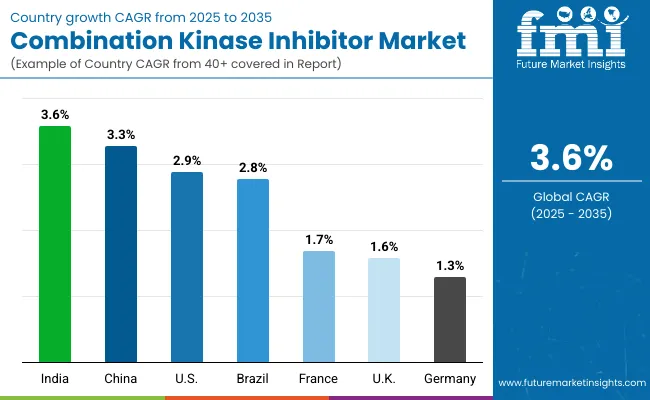
| Countries | CAGR (2025 to 2035) |
|---|---|
| India | 3.6% |
| China | 3.3% |
| USA | 2. 2 % |
| Brazil | 2.8% |
| France | 1.7% |
| UK | 1.6% |
| Germany | 1.3% |
The combination kinase inhibitor market is experiencing varied growth globally, with India leading at a 3.6% CAGR through 2035, driven by expanding healthcare infrastructure, increasing cancer awareness, and growing access to oncological medications. China follows at 3.3%, supported by healthcare system reforms, increasing recognition of cancer treatment importance, and expanding pharmaceutical coverage. The USA shows growth at 2.9%, representing a mature market with established treatment patterns and regulatory frameworks. Brazil demonstrates growth at 2.8%, emphasizing improved access to oncological care and combination therapy adoption. Europe records 1.8% growth, focusing on evidence-based treatment protocols and comprehensive cancer care systems.
The report covers an in-depth analysis of 40+ countries; seven top-performing countries are highlighted below.
Revenue from combination kinase inhibitors in China is projected to exhibit steady growth with a CAGR of 3.3% through 2035, driven by ongoing healthcare system reforms and increasing recognition of cancer treatment as a priority health issue. The country's expanding healthcare infrastructure and growing availability of specialized oncology services are creating significant opportunities for combination therapy adoption. Major international and domestic pharmaceutical companies are establishing comprehensive distribution networks to serve the growing population of patients requiring complex oncological treatment across urban and developing regions.
Revenue from combination kinase inhibitors in India is expanding at a CAGR of 3.6%, supported by increasing healthcare accessibility, growing cancer awareness, and expanding pharmaceutical market presence. The country's large patient population and increasing recognition of oncological conditions are driving demand for effective combination therapy solutions. International pharmaceutical companies and domestic manufacturers are establishing distribution channels to serve the growing demand for quality oncological medications.
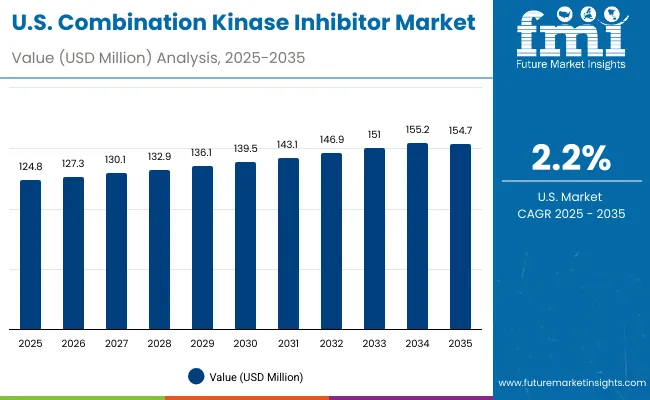
Demand for combination kinase inhibitors in the USA is projected to grow at a CAGR of 2.2%, supported by well-established oncological care systems and evidence-based treatment guidelines. American healthcare providers consistently utilize combination therapies for treatment-resistant conditions and complex oncological presentations. The market is characterized by mature treatment protocols, comprehensive insurance coverage, and established relationships between healthcare providers and pharmaceutical companies.
Revenue from combination kinase inhibitors in Brazil is projected to grow at a CAGR of 2.8% through 2035, driven by healthcare system development, increasing access to oncological care, and growing recognition of cancer treatment importance. Brazilian healthcare providers are increasingly adopting combination therapy approaches for complex oncological conditions, supported by expanding pharmaceutical market presence and improved treatment accessibility.
Revenue from combination kinase inhibitors in the UK is projected to grow at a CAGR of 1.6% through 2035, supported by the National Health Service framework and comprehensive evidence-based treatment guidelines that facilitate appropriate use of combination therapies for complex oncological conditions. British healthcare providers consistently utilize established protocols for combination therapy management, emphasizing patient outcomes and treatment optimization within integrated care systems.
Revenue from combination kinase inhibitors in Germany is projected to grow at a CAGR of 1.3% through 2035, supported by the country's well-established oncological care infrastructure, comprehensive healthcare coverage, and systematic approach to cancer treatment. German healthcare providers emphasize evidence-based combination therapy utilization within structured healthcare frameworks that prioritize clinical effectiveness and patient safety.
Revenue from combination kinase inhibitors in France is projected to grow at a CAGR of 1.7% through 2035, supported by the country's comprehensive healthcare system, established oncological care infrastructure, and systematic approach to cancer treatment. French healthcare providers emphasize evidence-based combination therapy utilization within integrated care frameworks that prioritize patient outcomes and treatment continuity.
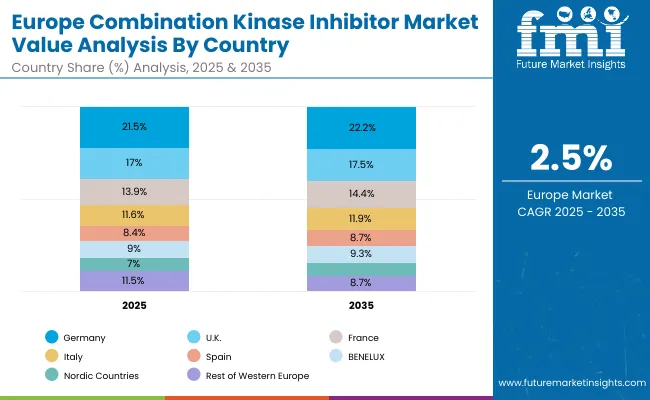
The combination kinase inhibitor market in Europe is projected to expand steadily through 2035, supported by increasing adoption of targeted therapy approaches in oncology, rising prevalence of complex cancers and autoimmune disorders, and ongoing clinical innovation in multi-target therapies. Germany will continue to lead the regional market, accounting for 21.5% in 2025 and rising slightly to 22.2% by 2035, supported by a strong clinical research base, reimbursement pathways, and robust oncological care infrastructure. The United Kingdom follows with 17.0% in 2025, increasing to 17.5% by 2035, driven by NHS adoption of advanced treatment guidelines, digital health integration, and broadening specialist networks.
France holds 13.9% in 2025, edging up to 14.4% by 2035 as oncology hospitals expand multi-drug therapy protocols and demand grows for tailored treatment regimens. Italy contributes 11.6% in 2025, remaining broadly stable at 11.9% by 2035, supported by strong regional cancer programs and growing clinical trial participation. Spain represents 8.4% in 2025, inching upward to 8.7% by 2035, underpinned by strengthening access to oncological services and patient support programs.
BENELUX markets together account for 9.0% in 2025, moving to 9.3% by 2035, supported by innovation-friendly regulatory frameworks and academic-industry collaboration. The Nordic countries represent 7.0% in 2025, marginally increasing to 7.2% by 2035, with demand fueled by progressive healthcare systems and early adoption of evidence-based oncological care. The Rest of Western Europe moderates from 11.5% in 2025 to 8.7% by 2035, as larger core markets capture a greater share of investment, clinical trials, and adoption of combination therapy protocols.
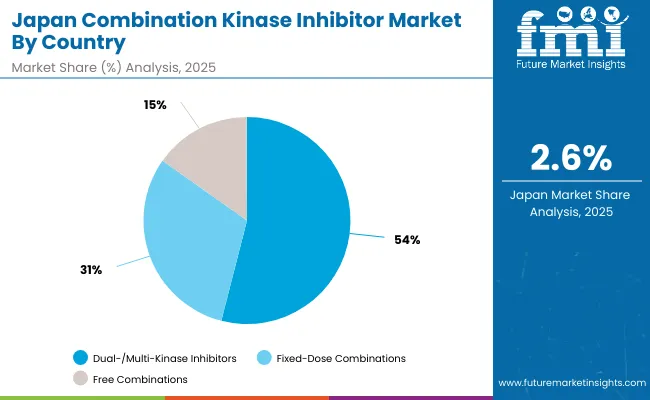
The combination kinase inhibitor market in Japan is set to remain diversified across several therapy types in 2025, reflecting clinical preferences in oncological practice and evolving prescribing patterns. Dual-/Multi-Kinase Inhibitors dominate with a 54.0% share in 2025, supported by their central role in managing treatment-resistant cancers, complex oncological presentations, and multi-pathway targeting approaches.
Fixed-Dose Combinations represent 30.8% in 2025, gaining traction from pipeline approvals targeting various cancers with adjunctive therapeutic benefits. Free Combinations hold 15.2%, sustained by their widespread use for personalized dosing approaches and individualized treatment protocols in complex oncological disorders.
The segmentation reflects the growing role of precision oncology and experimental adjunctive approaches entering clinical practice, with healthcare providers increasingly adopting multi-modal treatment strategies for optimal patient outcomes.
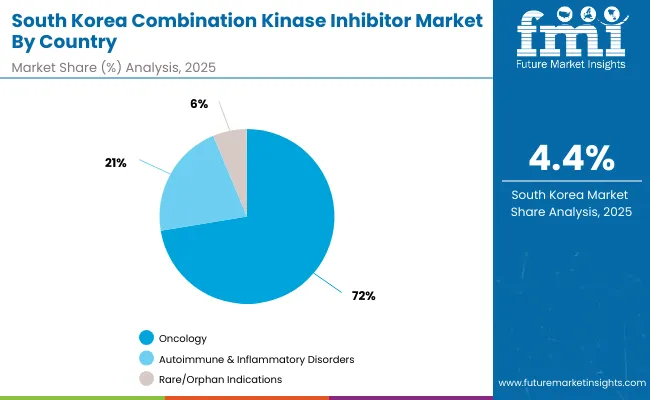
The combination kinase inhibitor market in South Korea in 2025 is shaped by strong demand across core oncological indications, reflecting both clinical prevalence and treatment guidelines. Oncology accounts for the largest share at 72.4%, supported by high rates of kinase inhibitor utilization, targeted therapy adoption, and increasing integration of combination therapies to address treatment resistance.
Autoimmune & Inflammatory Disorders follow with 21.3%, driven by the rising burden of inflammatory conditions, heightened awareness about targeted therapy options, and wider reimbursement for kinase inhibitor combination protocols. Rare/Orphan Indications contribute 6.3%, supported by the established use of specialized therapies for uncommon conditions and expanding clinical research in orphan disease areas.
The segmentation highlights opportunities for pipeline therapies and expanded clinical adoption across diverse therapeutic areas, reflecting the growing importance of personalized medicine approaches in Korean healthcare systems.
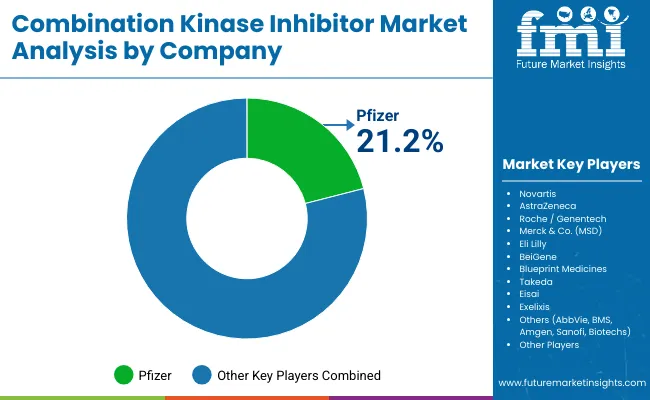
The combination kinase inhibitor market is characterized by competition among established pharmaceutical companies, specialty oncology focused firms, and biotechnology companies. Companies are investing in clinical research, regulatory compliance, strategic partnerships, and healthcare provider education to deliver effective, safe, and accessible combination therapy solutions. Drug development, clinical validation, and market access strategies are central to strengthening product portfolios and market presence.
Pfizer, USA-based, leads the market with 21.2% global value share, offering clinically-proven combination kinase inhibitors with a focus on efficacy and patient outcomes. Novartis provides comprehensive oncological combination products with emphasis on precision medicine and targeted therapy approaches. AstraZeneca focuses on innovative formulation technologies and specialized delivery systems for combination therapies. Roche/Genentech delivers established combination products with strong clinical evidence and healthcare provider acceptance.
Merck & Co. (MSD) operates with comprehensive oncological medication portfolios including combination products across multiple therapeutic areas. Eli Lilly provides innovative combination therapies with focus on personalized treatment approaches. Bei Gene specializes in targeted oncology therapies with emphasis on combination treatment protocols. Blueprint Medicines focuses on precision medicine approaches for rare diseases and oncological conditions. Takeda, Eisai, and Exelix is provide specialized formulations and targeted therapies to enhance market accessibility and patient access to essential combination treatments.
Key Players in the Combination Kinase Inhibitor Market
| Items | Values |
|---|---|
| Quantitative Units (2025) | USD 400.5 Million |
| Drug Type | Dual-/Multi-Kinase Inhibitors, Fixed-Dose Combinations, Free Combinations |
| Indication | Oncology, Autoimmune & Inflammatory Disorders, Rare/Orphan Indications |
| Sales Channel | Hospital Pharmacies, Specialty Pharmacies, Retail Pharmacies, Online Pharmacies |
| Regions Covered | North America, Europe, East Asia, South Asia & Pacific, Latin America, Middle East & Africa |
| Countries Covered | United States, Canada, United Kingdom, Germany, France, China, Japan, South Korea, India, Brazil, Australia and 40+ countries |
| Key Companies Profiled | Pfizer, Novartis, AstraZeneca, Roche/Genentech, Merck & Co. (MSD), Eli Lilly, BeiGene , Blueprint Medicines, Takeda, Eisai, Exelixis |
| Additional Attributes | Dollar sales by combination type and therapeutic indication, regional demand trends, competitive landscape, healthcare provider preferences for specific combinations, integration with specialty pharmacy channels, innovations in targeted therapy formulations, patient adherence monitoring, and clinical outcome optimization |
The global combination kinase inhibitor market is valued at USD 400.5 million in 2025.
The size for the combination kinase inhibitor market is projected to reach USD 570.4 million by 2035.
The combination kinase inhibitor market is expected to grow at a 3.6% CAGR between 2025 and 2035.
The key product type segments in the combination kinase inhibitor market are dual-/multi-kinase inhibitors, selective kinase inhibitor combinations, and kinase + non-kinase combinations.
In terms of product type, dual-/multi-kinase inhibitors segment is set to command 54.5% share in the combination kinase inhibitor market in 2025.






Our Research Products

The "Full Research Suite" delivers actionable market intel, deep dives on markets or technologies, so clients act faster, cut risk, and unlock growth.

The Leaderboard benchmarks and ranks top vendors, classifying them as Established Leaders, Leading Challengers, or Disruptors & Challengers.

Locates where complements amplify value and substitutes erode it, forecasting net impact by horizon

We deliver granular, decision-grade intel: market sizing, 5-year forecasts, pricing, adoption, usage, revenue, and operational KPIs—plus competitor tracking, regulation, and value chains—across 60 countries broadly.

Spot the shifts before they hit your P&L. We track inflection points, adoption curves, pricing moves, and ecosystem plays to show where demand is heading, why it is changing, and what to do next across high-growth markets and disruptive tech

Real-time reads of user behavior. We track shifting priorities, perceptions of today’s and next-gen services, and provider experience, then pace how fast tech moves from trial to adoption, blending buyer, consumer, and channel inputs with social signals (#WhySwitch, #UX).

Partner with our analyst team to build a custom report designed around your business priorities. From analysing market trends to assessing competitors or crafting bespoke datasets, we tailor insights to your needs.
Supplier Intelligence
Discovery & Profiling
Capacity & Footprint
Performance & Risk
Compliance & Governance
Commercial Readiness
Who Supplies Whom
Scorecards & Shortlists
Playbooks & Docs
Category Intelligence
Definition & Scope
Demand & Use Cases
Cost Drivers
Market Structure
Supply Chain Map
Trade & Policy
Operating Norms
Deliverables
Buyer Intelligence
Account Basics
Spend & Scope
Procurement Model
Vendor Requirements
Terms & Policies
Entry Strategy
Pain Points & Triggers
Outputs
Pricing Analysis
Benchmarks
Trends
Should-Cost
Indexation
Landed Cost
Commercial Terms
Deliverables
Brand Analysis
Positioning & Value Prop
Share & Presence
Customer Evidence
Go-to-Market
Digital & Reputation
Compliance & Trust
KPIs & Gaps
Outputs
Full Research Suite comprises of:
Market outlook & trends analysis
Interviews & case studies
Strategic recommendations
Vendor profiles & capabilities analysis
5-year forecasts
8 regions and 60+ country-level data splits
Market segment data splits
12 months of continuous data updates
DELIVERED AS:
PDF EXCEL ONLINE
Kinase Inhibitors For Cancer Treatment Market Size and Share Forecast Outlook 2025 to 2035
Kinase Inhibitor in Autoimmune Diseases Market Size and Share Forecast Outlook 2025 to 2035
Protein Kinase B Inhibitors Market
Janus Kinase (JAK) Inhibitors Market
Cyclin-Dependent Kinase Inhibitor Market Size and Share Forecast Outlook 2025 to 2035
Bruton's Tyrosine Kinase (BTK) Inhibitors Market
Combination Antihypertensive Agents Market Analysis - Size, Share, and Forecast Outlook 2025 to 2035
Combination Spanner Set Market Size and Share Forecast Outlook 2025 to 2035
FcRn Inhibitors Market Size and Share Forecast Outlook 2025 to 2035
PARP Inhibitor Market Analysis – Size, Share, and Forecast Outlook 2025 to 2035
CGRP Inhibitors Market Trends - Growth, Demand & Forecast 2025 to 2035
Fuse Combination Unit Market Growth - Trends, Analysis & Forecast by Type, Current Rating, Application, End-use Industry and Region through 2035
Global KRAS Inhibitor Market Analysis – Size, Share & Forecast 2024-2034
PCSK9 Inhibitor Market Forecast Outlook 2025 to 2035
SGLT2 Inhibitors Market Size and Share Forecast Outlook 2025 to 2035
SGLT2 Inhibitors Treatment Market Overview – Trends & Growth 2024-2034
NF-KB Inhibitors Market
Mould Inhibitors Market
Enzyme Inhibitors Market
Creatine Kinase Reagent Market Size and Share Forecast Outlook 2025 to 2035

Thank you!
You will receive an email from our Business Development Manager. Please be sure to check your SPAM/JUNK folder too.
Chat With
MaRIA